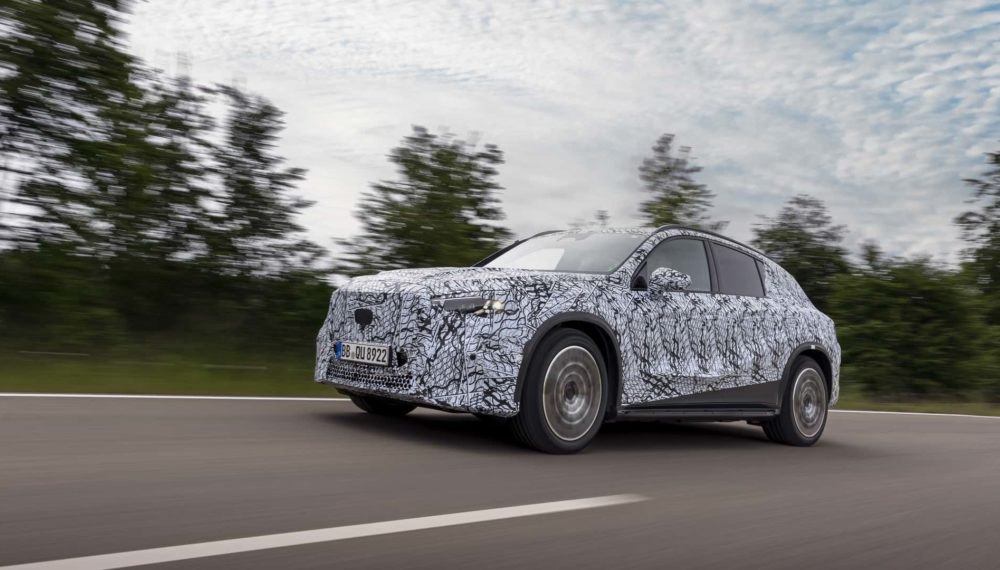Mercedes-Benz fuel cell vehicles have already demonstrated their day-to-day suitability, including in large-scale field-trials. With more than 100 test vehicles and a combined total of over 4.5 million kilometres of trial testing, the company boasts the most extensive experience with fuel cell-based electric drive systems of any manufacturer worldwide. However, certain challenges still need to be overcome, including a nationwide network of hydrogen filling stations, before local zero-emission motoring can become a widespread reality.
Mercedes-Benz can fall back on its extensive experience in fuel cell technology: since 1994 the Stuttgart-based car maker has been conducting research into the use of the electric drive with fuel cells in the motor car, thus building up outstanding technology know-how. Some 180 registered patents in the field of fuel cell technology are testimony to the company’s pioneering work. As part of various large-scale field tests involving fuel cell vehicles, 100 Mercedes-Benz passenger cars, buses and vans have been in daily use on the road with customers and have already clocked up over 4.5 million kilometres. Such tests provide important insights for the further development of the local zero-emission drive system – also in relation to user behaviour when utilising the new technology.
Joint initiatives promote infrastructure
Daimler AG reached a significant milestone in terms of a sufficient supply of hydrogen in September 2009 by joining forces with EnBW, Linde, OMV, Shell, Total, Vattenfall and NOW GmbH (Nationale Organisation Wasserstoff- und Brennstoffzellentechnologie). In a memorandum of understanding the partners agreed to a plan to set up a filling station network in two phases. Phase I will examine various options for setting up a nationwide hydrogen filling station network as well as developing a joint, economically viable business concept. The aim is also to develop concepts for setting up new, additional hydrogen filling stations by 2011. If the business continues to perform well, the partners will then implement a suitable action plan in Phase II. This forms the basis for the nationwide roll-out of a hydrogen filling station network. This initiative receives funding as part of the German government’s Recovery Package II. Daimler AG, Ford Motor Company, General Motors Corporation/Opel, Honda Motor Co., Ltd., Hyundai Motor Company, Kia Motors Corporation, the joint venture Renault SA and Nissan Motor Co. Ltd. and Toyota Motor Corporation agreed previously in a letter of understanding to commercialise fuel cell vehicles from 2015 onwards.
Daimler AG has been committed to promoting this important issue for many years, reflected in its participation in joint projects, cooperation with government agencies, power utilities and oil companies in places such as Hamburg, Stuttgart and California. The City of Hamburg has become the centre for local zero-emission mobility on the basis of the electric drive with fuel cells. In the spring, the City teamed up with Daimler, Shell, Total and Vattenfall Europe to launch a major project for the use of passenger cars and buses using fuel cell technology. From the end of 2010 the first of a total of ten latest-generation fuel cell buses will be on the roads in Hamburg. They will be joined by 20 B‑Class F‑CELL vehicles. By 2014 a total of four hydrogen filling stations should be up and running. The aim of the joint initiative is to promote the development of a zero-emission vehicle fleet and the associated infrastructure. In cooperation with Linde AG and Daimler AG, OMV turned its Stuttgart Airport site into the first public hydrogen filling station in Baden-Württemberg in June 2009. In the USA, Daimler AG is promoting fuel cell technology in the car as part of the California Fuel Cell Partnership.
Hydrogen as an energy source
A decisive advantage of electric vehicles with a fuel cell drive system is that they generate zero emissions locally. Just how much CO2 is generated during hydrogen production depends on the form of energy or the process used. The bulk of the hydrogen required today is generated by means of a steam reforming process. Natural gas and water vapour are processed in the steam reformer at high temperatures to produce hydrogen, carbon monoxide and carbon dioxide in the first instance. The following step involves converting the carbon monoxide component into carbon dioxide and hydrogen through the addition of steam. The highly efficient fuel cell means the overall CO2 emissions of 20 to 30 percent are already well below those for ultra-modern diesel vehicles.
Furthermore, hydrogen can also be easily produced from renewable energy sources, such as wind and solar power. This allows hydrogen to be produced by means of electrolysis, as well as through the use of biomass. The synthesis gas (essentially carbon monoxide and hydrogen) produced in the initial process stage is converted into carbon dioxide and hydrogen. As the proportion of renewable energy is increased, so the process moves ever closer to an entirely CO2-neutral energy chain.
Combustion engine remains the most important drive system
Mercedes-Benz sees the development of electric vehicles with battery and fuel cell for tomorrow’s local zero-emission driving as a way of supplementing the extremely clean, economical BlueEFFICIENCY models and hybrid vehicles already available. However, a range of limiting factors still exists, such as system costs and infrastructure, as well as range and performance for battery-driven vehicles in particular, when it comes to smooth, comfortable operation. Advanced diesel and petrol engines will remain important for automotive applications for a long time to come – not only for individual mobility in passenger cars – especially over long distances – but, more importantly, for freight transport in trucks. Electric vehicles, on the other hand, will increasingly be used in urban transport. Consequently, Mercedes-Benz has developed a wide-ranging portfolio of solutions. And as part of this strategy the combustion engine will continue to play a crucial role. Despite enormous progress, the electric car – whether powered by a fuel cell or a battery – cannot completely replace vehicles powered by a combustion engine over the short-term.



















